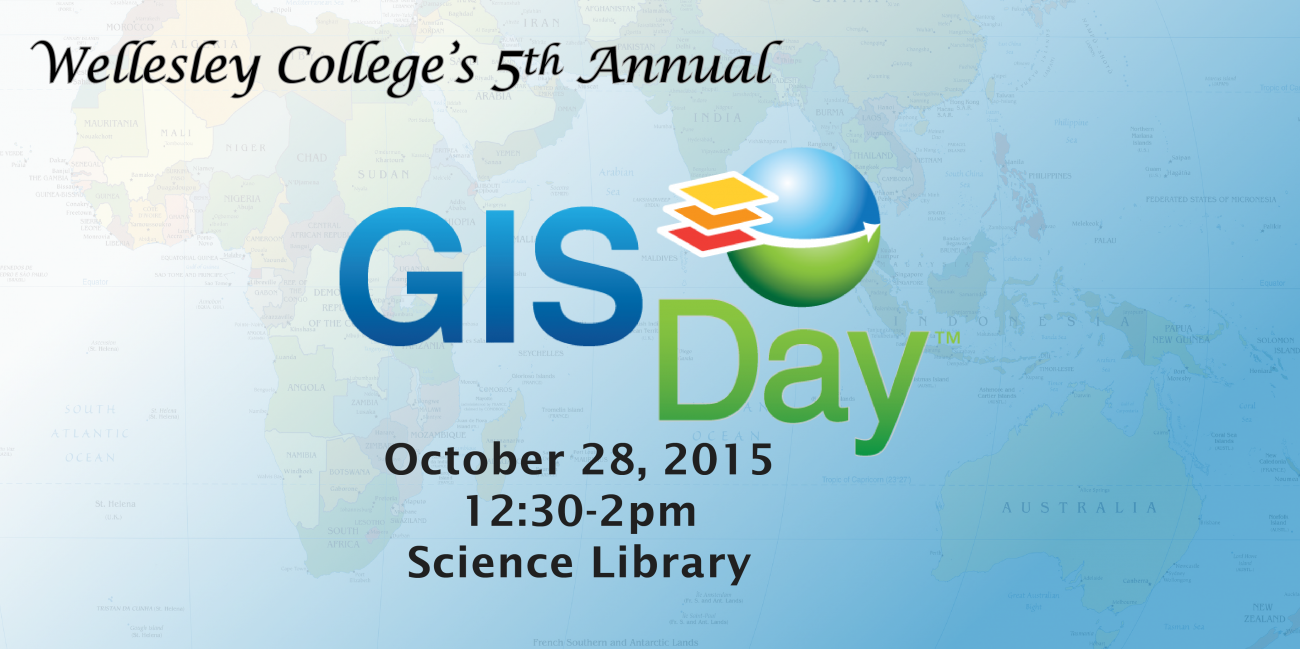
GIS Day is held each November during Geography Awareness Week, with events in more than 80 countries.
Wellesley's fifth annual GIS Day is hosted by the Quantitative Reasoning Program and Library & Technology Services. This year, GIS Day will be held on Wednesday, October 28, 12:30-2pm, in the Science Library. We hope that you will join us to learn more about how faculty, staff, and students are using GIS, mapping, and spatial analysis!
About GIS
Geographic Information Systems are the tools used to store, view, and analyze spatial information. Geographic Information Science deals with the underlying conceptual issues of representing data and processes in space and time. GIS is used in numerous courses and research projects at Wellesley and in the community.
2015 Schedule
| 12:30 - 1:40 | Lightning Talks by Faculty, Staff, and Students |
| 1:40 - 2 | Cake Social |
| All Day | Posters on Display in Science Library |
2015 Speaker Information
- Mary Yearl, Archives, "Alternate Realities as Found in the Archives"
- Alexander Morrow and Jason Lan, Olin College of Engineering, "BOW GNSS Receiver Project"
- Sarah Barbrow, Research & Instruction Support, "Social Explorer"
- Stephen Marini and Anne Meyers, Religion, "Mapping Religious Change in Revolutionary America"
- Dan Brabander, Maria Waller, and Kathleen Gilbert, Geosciences, "Spatial Thinking in 4-D: A Project-Based Approach to Link Student-Collected Field Data, GIS Mapping, and Archive Research"
- Kartini Shastry, Economics, "Using GIS to Estimate the Breastfeeding Response to Exposure to Arsenic-Contaminated Drinking Water"
- Jordan Tynes, Research & Instruction Support, "3D Scanning Topography and Architecture with Drones"
Photos from Previous GIS Days
2014 Speaker:
Prehistory by the Numbers: Remote Sensing and Numerical Models of Ancient Socio-environmental Dynamics in Southern Peru
Ben Vining – Visiting Professor of Anthropology
As our concern for recent environmental change grows, archaeology offers invaluable insights into how cultural and environmental change intersect over the long-term. Palaeoclimatic and archaeological investigations in southern Peru show stable land use over the past several millennia, despite climatic changes. Using satellite imagery and geospatial modeling, Prof. Vining reconstructs cultural decisions that shaped land use. Sustained interactions contributed to strong mutualism between culture and environmental systems, which continue to be important today.
2012 Speakers:
- Eric Hilt, Economics, "Financial History (and super low-tech GIS)" (slides)
- Mary Coyne, Biological Sciences, "WC Botanic Gardens: Trees on a Map to Trees in a Book"
- Kenny Freundlich, Library & Technology Services, "Mapping the Great Indoors: Google Indoor Maps for Clapp" (slides)
- Brian DuPont, Town of Wellesley, "Where do I Vote?...And Why?" (slides)
- Meg Thompson, Geosciences, "Bedrock Geologic Map of Greater Boston, Massachusetts: Digital Compilation with New U-Pb Zircon Age Constraints"
- Alden Griffith, Environmental Studies, "Teaching by Example using Habitat Suitability Analysis"
- Martha McNamara, Art, "Mapping Revolutionary Boston"
2011 Speakers:
- Dan Brabander, Geosciences, & Alden Griffith, Environmental Studies, " Using GIS and Spatially Linked Multivariable Statistics as a Hypotheses Generating Tool in Forensic Geochemistry "
- Jim Doyle, Grounds, "Keeping Track Of Our Trees"
- Carolin Ferwerda, Library & Technology Services, " DIY Aerial Photography "
- Patrick McEwan, Economics, "Using GIS to Estimate the Impact of a Welfare Program in Honduras"
- Katrin Monecke, Geosciences, "Coastal Progradation Patterns in Northern Sumatra as a Potential Tool in Earthquake and Tsunami Hazard Assessment"
- Marcy Thomas, Biological Sciences, " Taking Technology To The Field: Mobile Devices Track Purple Loosestrife "
- Meg Thompson, Geosciences, "Geologic Map-making via ArcGIS: An Example from the Boston Area"
- Jay Turner, Environmental Studies, "Mapping the History of Federal Land Protection"
- Wesley Watters, Astronomy, "OpenGIS Tools for Planetary Geology"
2010 Speakers:
- Britt Argow, Geosciences, "Quantitative Geomorphology using LiDAR along the New England Coast: Exploring the Process Implications of the Spatial Distribution of Features in 3D"
- Adrienne Lucas, Economics, "Defining Local School Markets Using Geocoded School Data: The First Step in Studying the Effects of Primary School Competition in Kenya"
- Brian DuPont, Town of Wellesley, "The 6 Ws...How GIS Informs the Who, What, Where, When, and Why for Wellesley"
- Jim Besancon, Geosciences, "Water, Water Everwhere"
- Kristina Jones & Tricia Diggins, Botanic Gardens & Environmental Studies, TBA
- Eni Mustafaraj, Computer Science, "The Google Maps API for Web Mashups"
- Patrick McEwan, Economics, "Using GIS to Improve Social Policy Research in Rural Areas of Honduras"
- Jessica Hunter, Environmental Studies, "Modeling the Effect of Greenways on Water Quality in Urbanizing Watersheds: Case Studies from the Woonasquatucket River Watershed, Rhode Island, and the Barigui River Watershed, Curitiba, Brazil"
- Marianne Moore, Biology, "Hot Spot Analysis of the Distribution of Species in Lake Baikal"
- Ann Borowik Parker, Town of Wellesley, "The Town of Wellesley's Wetland Viewer: Our First Public Internet Mapping Application"
- Rebecca Mattinson, Geosciences, "GPS-GIS Property Mapping"
- Marcy Thomas, Biology, "Visualizing the Environment: GIS for ES"
Questions?
Contact Carolin Ferwerda (LTS) or Corinne Taylor (QR)
